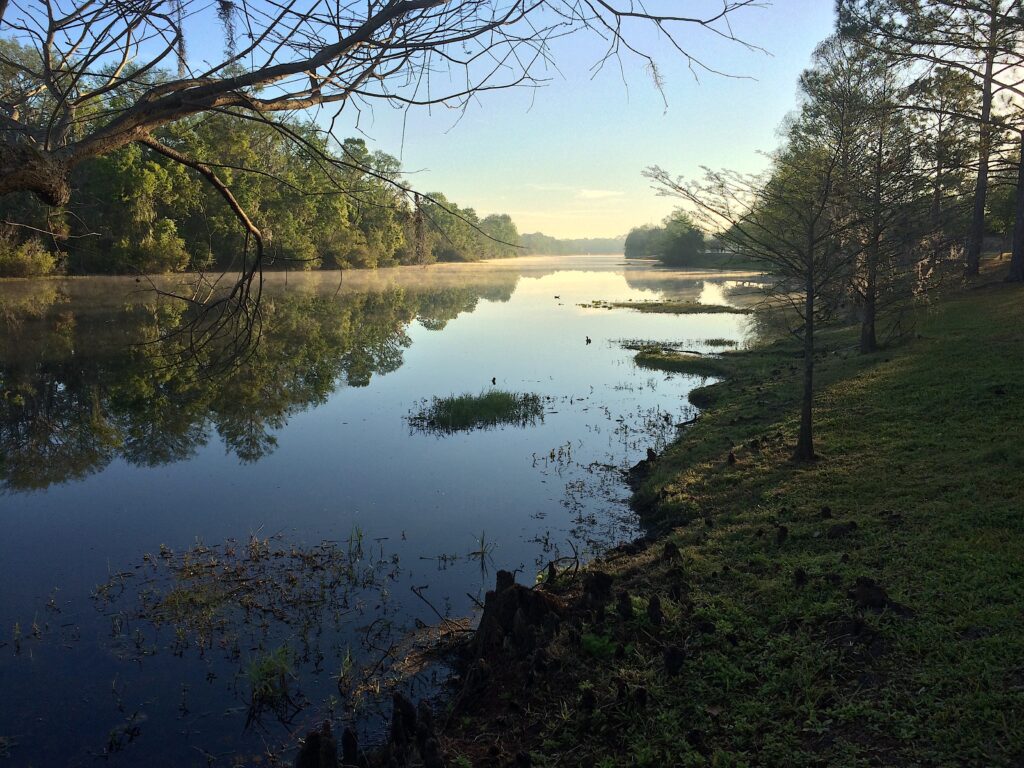
Little Econ River at Blanchard Park, west of Michael’s Dam, in east Orlando. Photo by Green Deane

The Econ’s water rose from below Michael’s dam — center right — to flood the YMCA, pool and parking lot, lower left.
When Hurricane Irma came through in 2017 it left 134 people dead and some flooding. One location that saw high water was Blanchard Park east of Orlando. It is on the Little Econ river which has eight dams to control flooding. Irma, from a foraging point of view made changes. It removed several edible species and left new ones. Not long ago Hurricane Ian also flooded the Little Eco in the same area significantly rising far higher than Irma did. At our foraging class there last week it was clear flood waters carried and deposited seeds. Several edible species not seen there before were sprouting, and several that previously were only waterside were several hundred feet from the main river. There were also many piles of debris which are always a foraging opportunity. Flooding can do great damage but it also changes plant species and their distribution creating new opportunities. Something to watch for when foraging
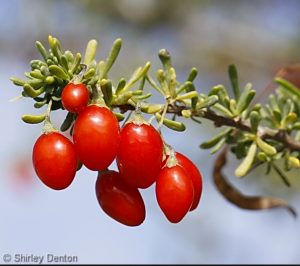
Goji berries are ripening.
As for Goji berries, this time of year we often find them sat Sprue Creek in Port Orange. Because of a rising tide we could not visit out usual location but we spotted some which we would have harvested if we had a canoe or kayak with us. Goji berries are a food/medicinal fruit popular in Asia and naturalized in Southern England. We have our own native species locally, Lycium carolinianum. The ripe fruit have a taste similar to tomatoes which they are related to.
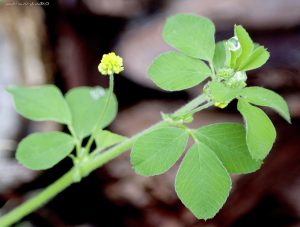
Related to Alfalfa, Black Medic is not a true clover. Photo by Green Deane
Saw Black Medic for the first time this season. It’s generally considered edible and like many weeds is from Europe. That kind of excludes it from being a significant Native American food (though some sources call it that… It’s a long story.) The headache is that from a distance of about five or six feet (where most people’s eyes are from the ground) Black Medic can look like Hop Clover. Here’s quick way to tell them apart: Hop Clover tends to have red stems, Black Medic has green stems covered with fine white hair and has a longer stem on the center leaf. After the two species go to seed they are easy to sort out: Black Medic has black seeds… hence the name. Hop Clover brown seeds. You can read more about it here.
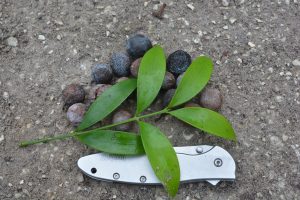
Nagi Trees are very prolific. Photo by Green Deane
The Nagi Tree is odd in that the seed oil is edible but the seed isn’t nor is the fruit. You can boil young leaves but they are kind of on par with pine needles (which are a distant relative). One odd thing is that the leaves clearly look like a monocot, that is, they don’t have branching veins but all parallel veins and no mid-rib in the leaf. The confusion is there are no monocot trees. These hurricane-proof trees produce piles of pretty blue berries that sprout easily (on their own in fact.) It’s just too bad they are not edible (neither are the blue fruit of the Japanese Blueberry Tree that resembles an olive.) You can read about the Nagi Tree here.
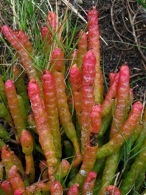
Red Glasswort shows it salty age. Photo by Green Deane
Botany Builder #26: Torose, also torulose: Cylindrical with swelling or contractions at intervals. It comes from the Dead Latin “torus” meaning a bulge or protuberance. Some might immediately think of certain cactus as torose, and some are. But other plants are torose as well, such as Glasswort, Salicornia bigelovii, found growing in salt marshes. We saw a lot of it this past week at Ft. Desoto. When young the plant is green but as the season goes on it sequesters salt in various area which then turn pink. So the green parts can be eaten raw or cooked and the pink parts used when you want a salty flavor. While the plant can be boiled to reduce the salty flavor the greens can also be put in what you’re cooking or flavor it such as a fresh caught fish or harvested squash. To read more about Glasswort go here.

Foraging classes are held rain, shine, hot or cold. Photo by Nermina Krenata
Foraging Classes: With the threat of weather lessened we can schedule further out. This week’s classes span the state.
Saturday December 17th, Dreher Park, 1200 Southern Blvd., West Palm Beach, 33405. Meet just north of the science center, 9 a.m.
Sunday December 18th, Eagle Park Lake, 1800 Keene Road, Largo, FL 33771.Meet in the pavilion next to the dog park. 9 a.m.
Saturday December 31st Blanchard Park, 2451 N Dean RD
Orlando, FL 32817. Meet at the pavilion next to the tennis courts.
Saturday January 7th Mead Garden: 1500 S. Denning Dr., Winter Park, FL 32789. Meet at the bathrooms. 9 a.m
Sunday January 8th, Wickham Park: 2500 Parkway Drive, Melbourne, FL 32935-2335. Meet at the “dog park” inside the park. 9 a.m.
Saturday January 15th the Princess Place Preserve, 2500 Princess Place Rd, Palm Coast, FL 32137, 9 a.m. Meet at the parking lot.
December 23rd: 12th Urban Crawl it is also time to mark your calendar for my 12th annual Urban Crawl. It will be Friday December 23rd at 10 a.m. in Winter Park, Florida. We meet in front of Panera’s, park avenue. It’s difficult to believe I’ve had that walk for twelve years now. The Urban Crawl is free to all.
For more information, to pre-pay or sign up go here.
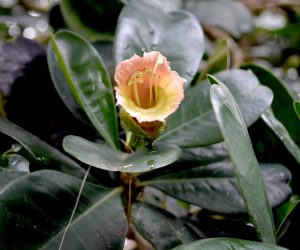
The blossom of the Black Calabash. Photo by Green Deane
We should see a a mystery during my Saturday class in West Palm Beach.WE should find the blossom to the right. The dreee has large, dark-leaves. It is the Black Calabash, Amphitecna latifolia. Reports vary on edibility. Most agree the black seeds are edible. One book, A Field Guide to Plants of Costa Rica, says the spongy white pulp is edible but does not mention the seeds which makes me cautious (in that the authors might confuse edible seeds for edible pulp.) Other reports say the tree does not fruit often unless the blossoms are intentionally pollenated. One last thing: The skin was dried and used like cups. It is pollenated by bats (which do not live in the area, making some believe it is not native and should be allowed to die off.)

Green Deane videos are now available on a USB.
A 150-video USB or 135 video DVD set would be a good winter present and either is now $99. My nine-DVD set of 135 videos has been selling for seven years and are still available. They are the same videos I have on You Tube. Some people like to have a separate copy. A second option is a16-gig USB that has those 135 videos plus 15 more. While the videos can be run from the DVDs the videos on the USB have to be copied to your computer to play. They are MP4 files. The150-video USB is $99 and the 135-video DVD set is now $99. The DVDs will be sold until they run out then will be exclusively replaced by the USB. This is a change I’ve been trying to make for several years. So if you have been wanting the 135-video DVD set order it now as the price is reduced and the supply limited. Or you can order the USB. My headache is getting my WordPress Order page changed to reflect these changes. We’ve been working on it for several months. However, if you want to order now either the USB or the DVD set make a $99 “donation” using the link at the bottom of this page or here. That order form provides me with your address, the amount — $99 — tells me it is not a donation and in the note say if you want the DVD set or the USB.
This is weekly newsletter #535. If you want to subscribe to this free newsletter you can find the sign-up form in the menu at the top of the page.
To donate to the Green Deane Newsletter click here.


There is a small photo of you beside a plant that is almost as tall as you, looking sort of like a thistle. I have a volunteer growing on my balcony that shot up after the rains that looks like it. What is it? Thank you
Very nice photo of the Little Econ. I remember tubing on that river in the early 70s.
Are the Lyceum carolinisum available to purchase seeds or plants and can they grow away from the coast? They’re not gojis but instead common name is Christmas berry? We got the barbanum —goji berry last year which are slowly growing but not sure now if they can grow here and actually produce. We do get more cold in our microclimate in the center of Florida in the Green Swamp.
I have goji berry Lycinum barbanum about a year still small ordered online. Wondering if they’ll grow and produce here in center of central Florida? Also wondering if someone has seeds or plants if the carolinum?